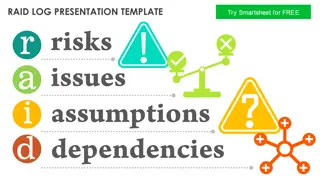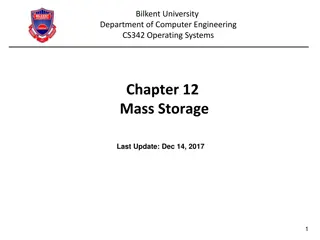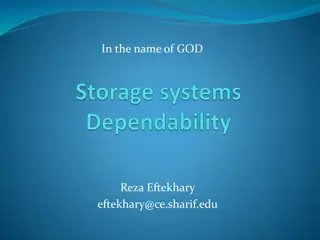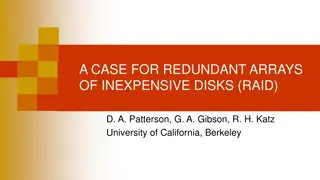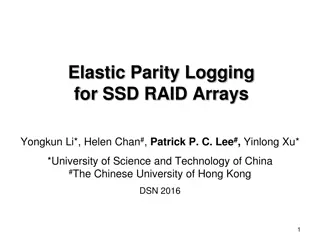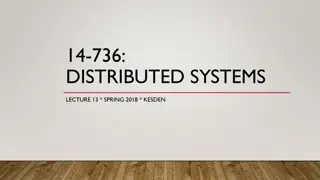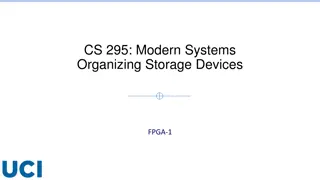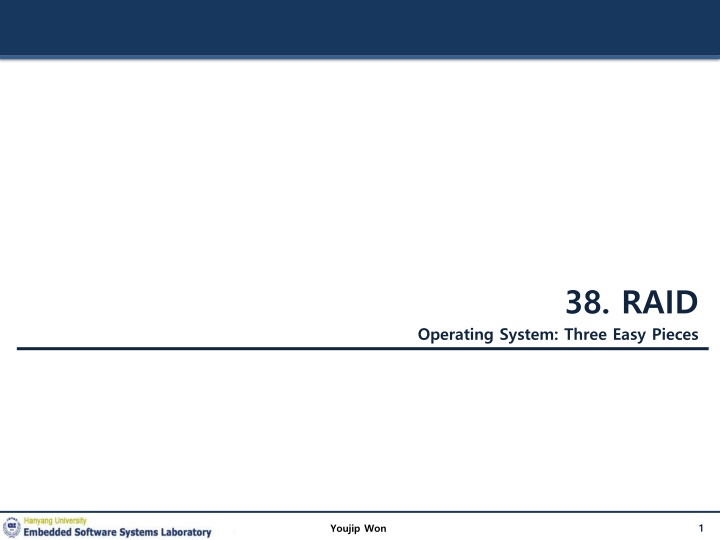
RAID Technology: Features, Internals, and Fault Tolerance
Discover the intricacies of RAID technology, from its performance and capacity advantages to fault models and evaluation criteria. Explore RAID levels, striping, redundancy, and more in this comprehensive guide. Learn how RAID operates, tackles disk faults, and maximizes system reliability and performance.
Download Presentation

Please find below an Image/Link to download the presentation.
The content on the website is provided AS IS for your information and personal use only. It may not be sold, licensed, or shared on other websites without obtaining consent from the author. If you encounter any issues during the download, it is possible that the publisher has removed the file from their server.
You are allowed to download the files provided on this website for personal or commercial use, subject to the condition that they are used lawfully. All files are the property of their respective owners.
The content on the website is provided AS IS for your information and personal use only. It may not be sold, licensed, or shared on other websites without obtaining consent from the author.
E N D
Presentation Transcript
38. RAID Operating System: Three Easy Pieces 1 Youjip Won
RAID (Redundant Array of Inexpensive Disks) Use multiple disks in concert to build a faster, bigger, and more reliable disk system. RAID just looks like a big disk to the host system. Advantage Performance & Capacity: Using multiple disks in parallel Reliability: RAID can tolerate the loss of a disk. RAIDs provide these advantages transparently to systems that use them. 2 Youjip Won
RAID Interface When a RAID receives I/O request, 1. The RAID calculates which disk to access. 2. The RAID issue one or more physical I/Os to do so. RAID example: A mirrored RAID system Keep two copies of each block (each one on a separate disk) Perform two physical I/Os for every one logical I/O it is issued. 3 Youjip Won
RAID Internals A microcontroller Run firmware to direct the operation of the RAID Volatile memory (such as DRAM) Buffer data blocks Non-volatile memory Buffer writes safely Specialized logic to perform parity calculation 4 Youjip Won
Fault Model RAIDs are designed to detect and recover from certain kinds of disk faults. Fail-stop fault model A disk can be in one of two states: Working or Failed. Working: all blocks can be read or written. Failed: the disk is permanently lost. RAID controller can immediately observe when a disk has failed. 5 Youjip Won
How to evaluate a RAID Capacity How much useful capacity is available to systems? Reliability How many disk faults can the given design tolerate? Performance 6 Youjip Won
RAID Level 0: Striping RAID Level 0 is the simplest form as striping blocks. Spread the blocks across the disks in a round-robin fashion. No redundancy Excellent performance and capacity Disk 0 Disk 1 Disk 2 Disk 3 Stripe (The blocks in the same row) 0 1 2 3 4 5 6 7 8 9 10 11 12 13 14 15 RAID-0: Simple Striping (Assume here a 4-disk array) 7 Youjip Won
RAID Level 0 (Cont.) Example) RAID-0 with a bigger chunk size Chunk size : 2 blocks (8 KB) A Stripe: 4 chunks (32 KB) Disk 0 Disk 1 Disk 2 Disk 3 0 2 4 6 chunk size: 2blocks 1 3 5 7 8 10 12 14 9 11 13 15 Striping with a Bigger Chunk Size 8 Youjip Won
Chunk Sizes Chunk size mostly affects performance of the array Small chunk size Increasing the parallelism Increasing positioning time to access blocks Big chunk size Reducing intra-file parallelism Reducing positioning time Determining the best chunk size is hard to do. Most arrays use larger chunk sizes (e.g., 64 KB) 9 Youjip Won
RAID Level 0 Analysis ? : the number of disks Capacity RAID-0 is perfect. Striping delivers N disks worth of useful capacity. Performance of striping RAID-0 is excellent. All disks are utilized often in parallel. Reliability RAID-0 is bad. Any disk failure will lead to data loss. 10 Youjip Won
Evaluating RAID Performance Consider two performance metrics Single request latency Steady-state throughput Workload Sequential: access 1MB of data (block (B) ~ block (B + 1MB)) Random: access 4KB at random logical address A disk can transfer data at S MB/s under a sequential workload R MB/s under a random workload 11 Youjip Won
Evaluating RAID Performance Example sequential (S) vs random (R) Sequential : transfer 10 MB on average as continuous data. Random : transfer 10 KB on average. Average seek time: 7 ms Average rotational delay: 3 ms Transfer rate of disk: 50 MB/s Results: S = ?????? ?? ???? ???? ?? ??????= 10 ?? 210 ??= 47.62 MB /s R = ?????? ?? ???? 10 ?? 10.195 ??= 0.981 MB /s ???? ?? ??????= 12 Youjip Won
Evaluating RAID-0 Performance ? : the number of disks Single request latency Identical to that of a single disk. Steady-state throughput Sequential workload : ? ? MB/s Random workload : ? ? MB /s 13 Youjip Won
RAID Level 1 : Mirroring RAID Level 1 tolerates disk failures. Copy more than one of each block in the system. Copy block places on a separate disk. Disk 0 Disk 1 Disk 2 Disk 3 0 0 1 1 2 2 3 3 4 4 5 5 6 6 7 7 Simple RAID-1: Mirroring (Keep two physical copies) RAID-10 (RAID 1+0) : mirrored pairs and then stripe RAID-01 (RAID 0+1) : contain two large striping arrays, and then mirrors 14 Youjip Won
RAID-1 Analysis ? : the number of disks Capacity: RAID-1 is Expensive The useful capacity of RAID-1 is N/2. Reliability: RAID-1 does well. It can tolerate the failure of any one disk (up to N/2 failures depending on which disk fail). 15 Youjip Won
Performance of RAID-1 Two physical writes to complete It suffers the worst-case seek and rotational delay of the two request. Steady-state throughput Sequential Write : ? 2 ? MB/s Each logical write must result in two physical writes. Sequential Read : ? 2 ? MB/s Each disk will only deliver half its peak bandwidth. Random Write : ? 2 ? MB/s Each logical write must turn into two physical writes. Random Read : ? ? MB/s Distribute the reads across all the disks. 16 Youjip Won
RAID Level 4 : Saving Space With Parity Add a single parity block A Parity block stores the redundant information for that stripe of blocks. * P: Parity Disk 0 Disk 1 Disk 2 Disk 3 Disk 4 0 0 1 1 P0 2 2 3 3 P1 4 4 5 5 P2 6 6 7 7 P3 Five-disk RAID-4 system layout 17 Youjip Won
RAID Level 4 (Cont.) Compute parity : the XOR of all of bits C0 0 0 C1 0 1 C2 1 0 C3 1 0 P XOR(0,0,1,1)=0 XOR(0,1,0,0)=1 Recover from parity Imagine the bit of the C2 in the first row is lost. Reading the other values in that row : 0, 0, 1 1. The parity bit is 0 even number of 1 s in the row 2. What the missing data must be: a 1. 3. 18 Youjip Won
RAID-4 Analysis ? : the number of disks Capacity The useful capacity is ? 1 . Reliability RAID-4 tolerates 1 disk failure and no more. 19 Youjip Won
RAID-4 Analysis (Cont.) Performance Steady-state throughput Sequential read: ? 1 ? MB/s Sequential write: ? 1 ? MB/s Disk 0 0 4 8 12 Disk 1 1 5 9 13 Disk 2 2 6 10 14 Disk 3 3 7 11 15 Disk 4 P0 P1 P2 P3 Full-stripe Writes In RAID-4 Random read: ? 1 ? MB/s 20 Youjip Won
Random write performance for RAID-4 Overwrite a block + update the parity Method 1: additive parity Read in all of the other data blocks in the stripe XOR those blocks with the new block (1) Problem: the performance scales with the number of disks 21 Youjip Won
Random write performance for RAID-4 (Cont.) Method 2: subtractive parity C0 0 C1 0 C2 1 C3 1 P XOR(0,0,1,1)=0 Update C2(old) C2(new) Read in the old data at C2 (C2(old)=1) and the old parity (P(old)=0) 1. Calculate P(new): ? ??? = ?2 ??? ??? ?2 ??? ??? ?(???) 2. If C2(new)==C2(old) P(new)==P(old) If C2(new)!=C2(old) Flip the old parity bit 22 Youjip Won
Small-write problem The parity disk can be a bottleneck. Example: update blocks 4 and 13 (marked with *) Disk 0 0 *4 8 12 Disk 1 1 5 9 *13 Disk 2 2 6 10 14 Disk 3 3 7 11 15 Disk 4 P0 +P1 P2 +P3 Writes To 4, 13 And Respective Parity Blocks. Disk 0 and Disk 1 can be accessed in parallel. Disk 4 prevents any parallelism. RAID-4 throughput under random small writes is (? ?) MB/s (terrible). 23 Youjip Won
A I/O latency in RAID-4 A single read Equivalent to the latency of a single disk request. A single write Two reads and then two writes Data block + Parity block The reads and writes can happen in parallel. Total latency is about twice that of a single disk. 24 Youjip Won
RAID Level 5: Rotating Parity RAID-5 is solution of small write problem. Rotate the parity blocks across drives. Remove the parity-disk bottleneck for RAID-4 Disk 0 Disk 1 Disk 2 Disk 3 Disk 4 0 1 2 3 P0 5 6 7 P1 4 10 11 P2 8 9 15 P3 12 13 14 P4 16 17 18 19 RAID-5 With Rotated Parity 25 Youjip Won
RAID-5 Analysis ? : the number of disks Capacity The useful capacity for a RAID group is ? 1 . Reliability RAID-5 tolerates 1 disk failure and no more. 26 Youjip Won
RAID-5 Analysis (Cont.) ? : the number of disks Performance Sequential read and write Same as RAID-4 A single read and write request Random read : a little better than RAID-4 RAID-5 can utilize all of the disks. Random write : ? 4 ? MB/s The factor of four loss is cost of using parity-based RAID. 27 Youjip Won
RAID Comparison: A Summary ? : the number of disks ? : the time that a request to a single disk take RAID-0 N RAID-1 N/1 1 (for sure) ? 2(if lucky) RAID-4 N-1 RAID-5 N-1 Capacity Reliability 0 1 1 Throughput Sequential Read Sequential Write Random Read N S N S N R N R (N/2) S (N/2) S N R (N/2) R (N-1) S (N-1) S (N-1) R (N-1) S (N-1) S N R 1 2R ? 4R Random Write Latency Read Write D D D D D 2D D 2D RAID Capacity, Reliability, and Performance 28 Youjip Won
RAID Comparison: A Summary Performance and do not care about reliability RAID-0 (Striping) Random I/O performance and Reliability RAID-1 (Mirroring) Capacity and Reliability RAID-5 Sequential I/O and Maximize Capacity RAID-5 29 Youjip Won
Disclaimer: This lecture slide set was initially developed for Operating System course in Computer Science Dept. at Hanyang University. This lecture slide set is for OSTEP book written by Remzi and Andrea at University of Wisconsin. 30 Youjip Won



